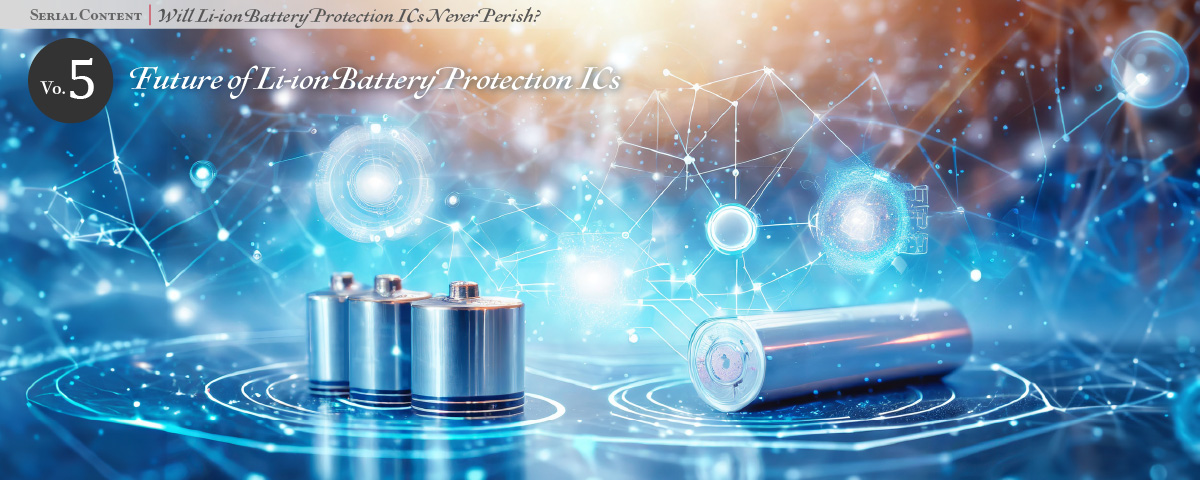Volume 5 (Final) Future of Li-ion Battery Protection ICs

A little long time has passed since I wrote the previous volume. This is the final volume of the series titled “the Future of Li-ion battery protection ICs.” Here, I will talk about trends of recent protection ICs, future functions and performance, and the ideal protection circuits for post-Li-ion batteries.
★
Unchanging Danger in Li-ion Batteries and Changes in Protection Circuits
30 years have passed since Li-ion batteries appeared in the market but firing accidents of them never stop until today.
In May 2023, a battery loaded on an electrically assisted bike started firing and burned the whole bike, which was widely broadcasted on the news. The cause of this accident seemed to lie in the use of a non-genuine battery. Using such batteries needs care because some of them have poor quality. Also, in August 2023, an accident was reported where firing occurred from a charger case of wireless earphones on the train. This was caused by the inner battery being crushed when the passenger moved the seats to swap front and back.
Although battery manufacturers conduct crush tests, the fact is that battery cells which fire due to crush appear on the market, as shown in this accident. Legal regulations on battery safety in Japan has not changed largely since the revision of Electrical Appliance and Material Safety Act in 2008. Internationally, on the other hand, changes start appearing in safety regulations; regulations for batteries for home appliances become stricter, which are shown in the updated version of the IEC safety regulations.
Then, what kind of change is occurring to protection circuits?
Reviewing the trends in protection circuits past 10 years reveals that more and more products use two protection ICs. While batteries in laptop PCs used a main protection IC and a second-protection IC which only had an overcharge protection function at the beginning of the adoption of Li-ion batteries, mobile phones used a single protection IC for a long time. However, major smartphone manufacturers started to adopt double protection using two protection ICs for higher safety, and other manufacturers followed the trend. Today, it is extremely common to use two protection ICs in a smartphone. Besides, to enhance safety, some smartphone batteries adopt protection ICs with temperature protection which were not used in the flip phone era.
★★
Prospecting Functions and Performance of Li-ion Battery Protection ICs After a Decade
Then, how will functions and performance of protection ICs change in a decade?
To be honest, current protection ICs are highly sophisticated. From the view of functions, I do not think there will be big change such as additional functions. The three most essential parameters for battery monitoring are voltage, current and temperature. In addition to these three main monitors, protection ICs contain other functions. Our task is, as a protection IC supplier, how we combine these functions efficiently.
On the other hand, how about the performance? I think, for example, overcharge protection and overcurrent protection will become more accurate. The day may come soon when consumer products require the overcharge protection accuracy of ±10 mV or less as a standard, which is already achieved for automotive products, to secure safety margin. Besides, as more small-capacity Li-ion batteries are used along with the prevalence of wearable devices, low current consumption is another keyword. It is possible that new products will appear that achieve lower current consumption than today.
★★★
Do post-Li-ion batteries, including all-solid-state batteries, need protection circuits?
So far, I talked about protection ICs for so-called Li-ion batteries. Lastly, let me think about post-Li-ion batteries. Development of post-Li-ion batteries is proceeding every day. The most expected post-Li-ion battery is all-solid-state batteries. How are protection circuits for all-solid-state batteries like? To begin with conclusion, nothing will change largely from the protection function adopted in conventional Li-ion batteries.
It is said in various situations that all-solid-state batteries have flameproof solid electrolyte and thus achieve high safety. However, I have never heard that anyone answers yes when they are asked if protection circuits are unnecessary to all-solid-state batteries. Risks of internal short remain even though liquid electrolyte is replaced by solid electrolyte, as it is thought that dendrites* grow at overcharge state. Also, they may also be deteriorated at overdischarge state, and cannot sweep away the dangers of heat generation or firing of battery cells or protection circuit boards at the flow of overcurrent such as short current.
*Dendrites: needle-shaped deposition of lithium metal crystal. Refer to Volume 1 for details.
Regarding temperature, although all-solid-state batteries have a wider operating temperature range than liquid-state Li-ion batteries, some claim that they need temperature protection as well. However, the set temperature differs from that of liquid-state Li-ion batteries, and even among all-solid-state batteries according to materials used.
Therefore, although there may be slight changes in specifications of each function, the basic way of using battery protection ICs is almost the same with current Li-ion battery protection ICs.
Various post-Li-ion batteries except all-solid-state batteries are under development: for example, sodium-ion batteries, potassium-ion batteries, magnesium secondary batteries, metal air batteries, etc. The concept of containing a protection circuit in a battery pack has been established by the appearance of Li-ion batteries. This notion will also be taken over by future batteries other than all-solid-state batteries; If there is a slight concern on the safety of the battery, protection circuits will be surely used in combination with safety measures of the battery itself.
Based on those thinking, neither protection circuits nor so-called protection ICs will perish in the future. Secondary batteries can be dangerous depending on their usage and conditions so not only safety measures on battery cells but also electrical measures by circuits are indispensable to use them safely. Protection ICs and secondary batteries have constructed strong connection. Again, I will answer to the question “will Li-ion battery protection ICs never perish?” which was posted before the beginning of this column series; I am sure as of now that protection ICs will continue existing as long as secondary batteries exist.
★★★★
Conclusion
Thank you for reading the five serial columns on Li-ion battery protection ICs. We will continue developing and evolving our protection ICs and are sure we can help you. Feel free to ask us about battery protection.
Published Mar. 26, 2024
Serial Content
Will Li-ion Battery Protection ICs Never Perish?
-
Future of Li-ion Battery Protection ICs
-
Measures for Trouble in Li-ion Battery Protection Circuits
-
Changes in Applications Using Li-ion Batteries -Customer Transition along with Application Expansion-
-
History of Li-ion Battery Protection ICs -Evolution of Performance and Package from Beginning to Present-
-
History of Li-ion Battery Protection ICs -Evolution of Functions from Beginning to Present-
-
-The Pioneer Says...- Will Li-ion Battery Protection ICs Never Perish?
Author profile

Akihiko Fujiwara
Nisshinbo Micro Devices Inc.
Akihiko Fujiwara has engaged himself in product planning and designing of our Li-ion battery protection ICs since 1990s, the dawn of secondary Li-ion batteries, which has made him famous in the industry. Now as an "expert in protection ICs," he devotes himself to marketing and planning and leads the path of protection ICs we should take, through collecting information on the latest trends in batteries and protection ICs worldwide.







